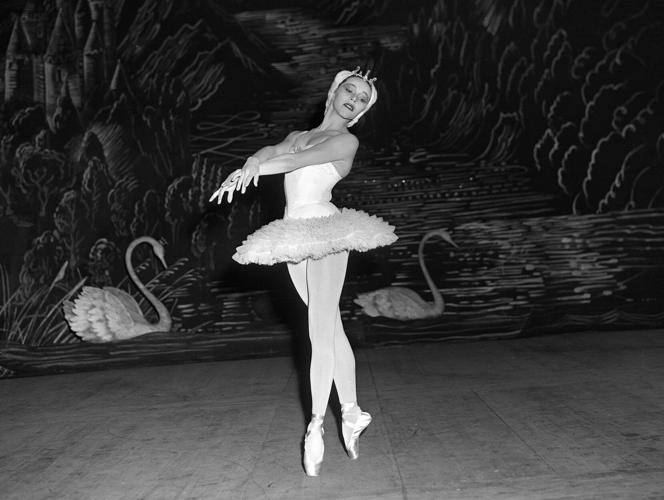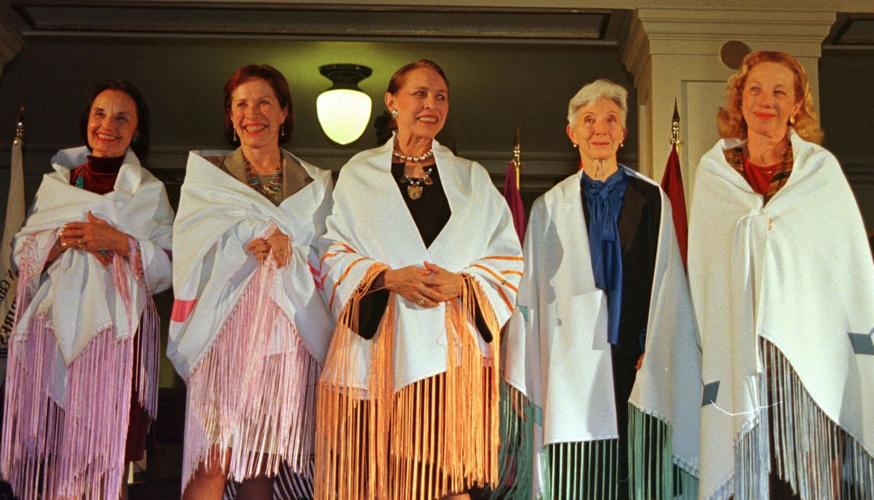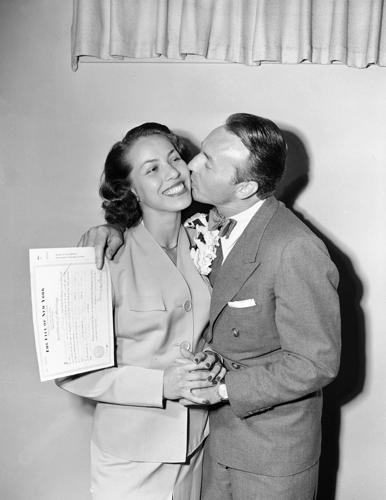Fairfax native Elizabeth Marie Tall Chief was well on her way to a career as a concert pianist when she chanced to attend a performance by the legendary dance company Ballet Russe de Monte Carlo.
“It was so romantic,” she later recalled, saying that the principal ballerinas of that company, Alexandra Danilova and Alicia Markova, “made an incredible impression on me and really opened my eyes to what ballet was. And I thought to myself, ‘That’s the kind of world I want to be in.’ Seeing the Ballets Russe was what started me thinking about becoming a dancer instead of a pianist.”
About a dozen years later, when she was performing with the New York City Ballet under the name Maria Tallchief, this citizen of the Osage Nation created a role that has inspired generations of young Americans to take up dance.

Maria Tallchief, prima ballerina of the New York City Ballet, performs in Tchaikovsky’s “Swan Lake” during the opening of the company’s engagement at the Scala Theater in Milan, Italy, on Sept. 14, 1953.
In December 1954, New York City Ballet debuted its first-ever full-length ballet of “The Nutcracker,” choreographed by George Balanchine, her former husband. Balanchine devised the role of the Sugar Plum Fairy for Tallchief, which she later stated was the most difficult part she ever had to dance.
Former Tulsa Tribune dance critic Lili Cockerille Livingston performed in New York City Ballet’s “The Nutcracker” as a youngster, and in her book “American Indian Ballerinas” recalled, “I distinctly remember that there was a special electricity on the stage and in the wings” when Tallchief performed as the Sugar Plum Fairy — a quality “that was missing when others performed the role.”
“The Nutcracker” was more than a triumph for Tallchief as a performer. It was salvation. The public’s enthusiasm for this ballet helped New York City Ballet remain in operation when it was facing financial ruin. It would become a part of the company’s touring program, with local youngsters brought in at each stop to perform on stage with the professional company.

Oklahoma’s five American Indian ballerinas, who have been declared Oklahoma Treasures, are Moscelyne Larkin, from left, Marjorie Tallchief, Maria Tallchief, Rosella Hightower and Yvonne Chouteau.
“The Nutcracker” — over 70 years and literally thousands of iterations — has become a staple of American ballet companies, as both a generator of income and as a way of introducing ballet to new generations.
“To me, that is one of her greatest legacies, because her performances in ‘The Nutcracker’ helped bring ballet to all of America and helped establish this ballet as a holiday tradition,” said Marcello Angelini, artistic director of Tulsa Ballet.
Over two decades — from 1942, when she joined the Ballet Russes de Monte Carlo as a teenager through her retirement from performing in 1965 — Maria Tallchief was, for many dance critics and fans, the epitome of the prima ballerina, thanks to her magnetic stage presence, her emotional expressiveness, and her technical prowess, which was the result of her tireless work ethic.

Artistic director and choreographer George Balanchine kisses his bride, ballet dancer Elizabeth Maria Tallchief, as he holds their marriage license on Aug. 16, 1946.
Livingston wrote that Tallchief essentially remade the look of a ballerina, saying that “the long-legged, fast-footed ballerina of contemporary ballet companies started with Tallchief’s partnership with Ballenchine.”
As the prima ballerina for New York City Ballet, Tallchief created dozens of indelible roles, many of them choreographed for her by Balanchine — “The Prodigal Son,” “Swan Lake,” “Allegro Brillante,” “Symphony in C” and “The Firebird,” which became her signature role.
This year, the dance world, and the world at large, has been celebrating what would have been the 100th birthday of Maria Tallchief, the first American prima ballerina and one of five ballerinas of Native heritage — along with Tallchief’s sister Marjorie, Rosella Hightower, Yvonne Chouteau and Tulsa Ballet co-founder Moscelyne Larkin — who would come to be known as Oklahoma’s Five Moons.

Mattel created a Maria Tallchief doll as part of its Inspiring Women series of Barbie dolls. The doll wears a costume inspired by the one Tallchief wore in the world premiere of “The Firebird,” one of her signature roles.
Earlier this year, New York City Ballet presented a program featuring three signature roles Balanchine created for Tallchief, staged by the daughter of André Eglevsky, who often performed as Tallchief’s on-stage partner.
Tallchief has also been honored by the U.S. Mint with special editions of quarter and dollar coins, featuring her in poses from her iconic “Firebird” role, as well as her Osage name, Wahle- ǫpa, which has been translated as “Two Standards” and “Woman of Two Worlds.” She was the subject of a “Google Doodle” on the popular search engine and last year received perhaps the ultimate pop culture accolade, when Mattel released a Maria Tallchief Barbie doll as part of its “Inspiring Women” series.
“It’s really been incredible,” said Elise Paschen, Tallchief’s daughter who has helped oversee many of the tributes to her mother and her artistic accomplishments. “I like to say that my mother is having a second renaissance.”

Prima Ballerina Maria Tallchief and Andre Eglevsky perform with the New York City Ballet at La Scala Theatre in Milan, Italy, in this undated photo. They are performing Tchaikovsky’s “Swan Lake.”
Tallchief was born in Fairfax in 1925. She began studying piano at age 3 and began taking dance lessons at age 5.
Ruth Porter Tallchief, the girls’ mother, originally planned for Maria to become a concert pianist, while Marjorie would become a dancer. But Maria’s natural talent and phenomenal stage presence quickly became apparent once the family moved to California, where the Tallchief girls studied ballet under Bronislava Nijinska.
At 17, she joined the corps de ballet of the Ballet Russe de Monte Carlo — partly because Tallchief had a passport, and the company was about to embark on a tour of Canada. She was encouraged to change her name to a Russian-esque pseudonym, but Tallchief refused.
“Even though she didn’t grow up immersed in the Osage culture, my mother was always very proud to be Osage,” Paschen said.

Maria Tallchief, center, is pictured Sept. 27, 1954. In background, principal Osage Chief Paul Pitts, right, talks to Osage Councilman Ben Ware. From far left are state Sen. Frank Mahan and Dave Ware of Pawhuska.
Two years later, Balanchine joined the company as its resident choreographer; two years after that, the two married. The union lasted only six years — because Balanchine did not want to have children, Tallchief had the marriage annulled — but the professional partnership would continue into the 1960s, as Tallchief’s performances in ballets by Balanchine and others helped create a uniquely American form of ballet.
Tallchief appeared several times in Tulsa, on tour with New York City Ballet, participating in the first Oklahoma Indian Ballerina Festival in 1957, and appearing as a guest artist with Tulsa Ballet in 1964, performing excerpts from “Giselle” and “Don Quixote.”

The Maria Tallchief Quarter depicts the ballerina in one of her signature roles, the title character from “The Firebird,” and it includes her Osage name: Wa-Xthe-Thonba, or “Woman of Two Worlds.”
She retired from performing in 1965 and devoted her energies to developing the dance scene in Chicago, where she made her home with her third husband, Henry D. Paschen Jr. Tallchief directed the ballet program at the Lyric Opera of Chicago, then founded Chicago City Ballet.
Among the accolades Tallchief received: a Kennedy Center Honor in 1996 for her contributions to American and world culture; the National Medal of Arts in 1999; inductions into the National Women’s Hall of Fame, the National Native American Hall of Fame and the Oklahoma Hall of Fame; and being named an Oklahoma Treasure in 1997. Tallchief has been immortalized in oil and in bronze along with her fellow Oklahoma Indian Ballerinas in Mike Larsen’s mural, “Flight of Spirit,” at the Oklahoma State Capitol and in “The Five Moons” sculpture on the grounds of the Tulsa Historical Society and Museum.

Ballerina Maria Tallchief
Tallchief has been the subject of a number of books, including her autobiography “Maria Tallchief: America’s Prima Ballerina.” Paschen, an award-winning poet and professor of poetry at the School of Art Institute in Chicago, has often written about her mother in her work, including her most recent collection, “Blood Wolf Moon.”
The first section of the book, “Heritage,” is a series of 14 interlinked poems that delve into her and her family’s Osage history, including how it was affected by the “Osage Reign of Terror,” depicted in the book and film “Killers of the Flower Moon,” as well as Paschen’s relationship with her mother and her mother’s legacy since her death in 2013.
“My mother had dementia, and after my dad died in 2005, she was really not herself until her death,” Paschen said. “For me, it became hard to remember my mother the way she was before the dementia took control of her. Writing this book allowed me not just to really dig deeper into our shared history and heritage, but also it allowed me to reclaim and remember her, to see her again in all her brilliance and beauty and complexity.”

“It’s really been incredible,” said Elise Paschen, Maria Tallchief’s daughter who has helped oversee many of the tributes to her mother and her artistic accomplishments. “I like to say that my mother is having a second renaissance.”
Paschen Author photo^J Elise Paschen^J Headshot 2^J April 2024 (Photographer Beowulf Sheehan)
“It’s really been incredible,” said Elise Paschen, Tallchief’s daughter who has helped oversee many of the tributes to her mother and her artistic accomplishments. “I like to say that my mother is having a second renaissance.”
Paschen also worked with the Osage Nation and the Balanchine Trust Foundation to make sure the representations of her mother were accurate.
“Throughout the past few years, in working with different organizations on these on these amazing projects honoring my mom, I’ve had to educate them quite a lot,” Paschen said. “But when I started working with Mattel on the Barbie, I was really dumbfounded, because I hardly had to edit anything. They understood her biography, and I think they presented her beautifully — and I was never much of a Barbie girl growing up.”

Maria Tallchief is depicted in a scene from the ballet “The Firebird,” one of her signature roles, in “The Five Moons,” statues of Oklahoma’s Indian Ballerinas at the Tulsa Historical Society and Museum.
The Maria Tallchief Barbie was officially launched with an event in Pawhuska, in which Paschen took part.
“What was especially moving to me,” she said, “was that Mattel gave a number of the dolls to the Osage Elementary School. The chief of the Osage Nation and I stood at the very end of the program and gave each child a Barbie, and oh my gosh, that meant the world to me, because I knew my mother would have just loved that.”

First lady Hillary Rodham Clinton applauds as President Bill Clinton congratulates Maria Tallchief after presenting her with a National Medal of Arts on Sept. 29, 1999 in Washington.
//leemun-rdcbh/MUN_RDC_DATA/RDC_Sites/TUL/InDesign/Pages/Adobe%20InDesign%20Documents/TUL_WRLD/11/D/Images/TUL_WRLD_051125_01_D_001_00_01/031b2bc2-ca71-4650-ad4a-4ea6de70436a/031b2bc2-ca71-4650-ad4a-4ea6de70436a.jpgCourtesy, Beowulf Sheehan
Paschen
Elise Paschen by Beowulf Sheehan
031b2bc2-ca71-4650-ad4a-4ea6de70436aAuthor photo^J Elise Paschen^J Headshot 2^J April 2024 (Photographer Beowulf Sheehan)//leemun-rdcbh/MUN_RDC_DATA/RDC_Sites/TUL/InDesign/Pages/Adobe%20InDesign%20Documents/TUL_WRLD/11/D/Images/TUL_WRLD_051125_01_D_001_00_01/37cb6e50-e986-11ef-9a96-131017b30966/37cb6e50-e986-11ef-9a96-131017b30966.jpgStephen Pingry, Tulsa World Archive
Maria Tallchief is depicted in a scene from the ballet “The Firebird,” one of her signature roles, in “The Five Moons,” statues of Oklahoma’s Indian Ballerinas at the Tulsa Historical Society and Museum.
Maria Tallchief
37cb6e50-e986-11ef-9a96-131017b30966IcyconditionsSPp01//leemun-rdcbh/MUN_RDC_DATA/RDC_Sites/TUL/InDesign/Pages/Adobe%20InDesign%20Documents/TUL_WRLD/11/D/Images/TUL_WRLD_051125_01_D_001_00_01/750a0016-fb69-11ef-a8e7-5b9e947cf9bc/750a0016-fb69-11ef-a8e7-5b9e947cf9bc.jpgCourtesy, United States Mint Department of Treasury
The Maria Tallchief Quarter depicts the ballerina in one of her signature roles, the title character from “The Firebird,” and it includes her Osage name: Wa-Xthe-Thonba, or “Woman of Two Worlds.”
Maria Tallchief Coin
750a0016-fb69-11ef-a8e7-5b9e947cf9bcMaria Tallchief Coin//leemun-rdcbh/MUN_RDC_DATA/RDC_Sites/TUL/InDesign/Pages/Adobe%20InDesign%20Documents/TUL_WRLD/11/D/Images/TUL_WRLD_051125_01_D_001_00_01/63e1d227-3e7d-421a-b4dd-b9b75cc4ccc1/63e1d227-3e7d-421a-b4dd-b9b75cc4ccc1.jpgJ. Scott Applewhite, Associated Press file
First lady Hillary Rodham Clinton applauds as President Bill Clinton congratulates Maria Tallchief after presenting her with a National Medal of Arts on Sept. 29, 1999 in Washington.
Maria Tallchief
63e1d227-3e7d-421a-b4dd-b9b75cc4ccc1051125-tul-scn-mariatall100p8//leemun-rdcbh/MUN_RDC_DATA/RDC_Sites/TUL/InDesign/Pages/Adobe%20InDesign%20Documents/TUL_WRLD/11/D/Images/TUL_WRLD_051125_01_D_001_00_01/5fdb2e55-3837-463e-a048-4aa0a4ae56c0/5fdb2e55-3837-463e-a048-4aa0a4ae56c0.jpgJOHN ROONEY, Associated Press file
Artistic director and choreographer George Balanchine kisses his bride, ballet dancer Elizabeth Maria Tallchief, as he holds their marriage license on Aug. 16, 1946.
Elizabeth Maria Tallchief
5fdb2e55-3837-463e-a048-4aa0a4ae56c0051125-tul-scn-mariatall100p7





















